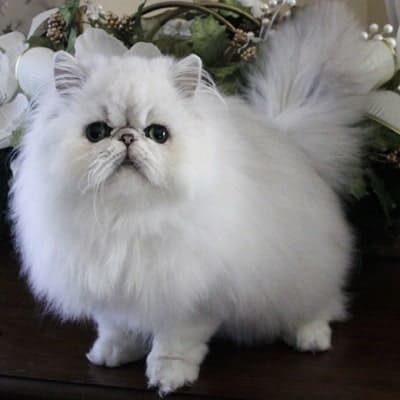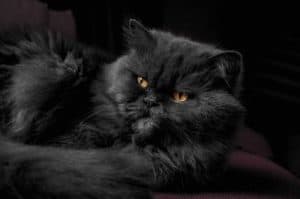
Long hair Shaded silver Persian cat. Photo: By Wyndcreste via Wikimedia Commons
Persian cat classification
The Perian Cat is classed as Group 1 (PER) by the Australian Cat Foundation (ACF).
Persian cat history
One of, if not the most popular breed, the Persian is one of the oldest known breeds of cat. The early history isn’t entirely known although it is generally accepted that the early cats came from Persia (now Iran) and Turkey. Italian traveller Pietro Della Valle (1586 – 1652) is credited with bringing the first Persian cats back to Europe, arriving in his homeland of Italy in 1620 with them.
By the 1800’s the Persian had become a popular breed in Europe and the first Persians arrived in America in the late 1800’s. In the Harpers Weekly supplement dated January 27, 1872, there is an illustration of several feline exhibits from the London Crystal Palace show, including a Persian cat.
They were popular pets of the time and had a special cachet because of Queen Victoria’s fondness for the breed. Even in the Victoria era, association with a “celebrity” ensured an animal’s desirability.
Persian cat physical characteristics
Large Persian Male cats can sometimes reach weights of over 5 ½ kgs with females being in a more modest range of between 3 to 5 kgs.

Persian cat. Photo: Stefan Ivanov/Unsplash
The Persian cat is a heavy boned, cobby type with short, thick legs with large paws. Persians are well muscled and medium to large in size. They have a short, thick neck, large shoulders, and a broad chest. It has a short tail which is in proportion to the body.
They have a large, broad head with large, round, expressive eyes set wide apart, small round tipped tufted ears which are set low on the head and wide apart. The nose is short, with a stop (or break) centred between the cat’s eyes. The overall expression is sweet and sometimes described as “pansy like“.
Some breeders are focusing on breeding Persians who resemble those from the past with less extreme features. These are known as Traditional, Doll or Old Style Persians.
Personality traits of the Persian cat
Persian cats have a sweet and gentle nature. Typically they have a laid back personality who are affectionate and enjoy the company of their carers. If you are out of the house for long periods of time, consider getting two cats so they have company.
The Persian will stretch out next to you, sleep in your bed, and sit on your lap when she is in the mood.
Persians are a quiet cat, easy going and generally get along with other pets and family members although boisterous children should be avoided. They are well behaved and don’t generally get up to any mischief. They are a quiet and calm cat but have a playful side also.
Persians are suited to an indoor life, they don’t tolerate noise as well as other breeds. Like most cats, they prefer routine and don’t like change.
Note: All cats are individuals. While there is a great difference between cat breeds there is also a difference in temperament within breeds. Temperament is affected by a number of factors, including heredity, training, and socialisation.
Persian cat Care
Diet – Persian cats are carnivores of the highest order. Persian cats (including kittens) need meat proteins – not veggies and fruit – and lots of it for their size. Persians like to feed twice a day and almost always eat well, even when schedules force the feedings a bit closer together. However, there will be times when a Persian kitten will not want to eat, but if the kitten doesn’t want to eat at any time during the day, then you may want to check with your vet. Both wet and dry food can be beneficial, especially when a specific purpose is indicated.
Wet food: A high quality canned food for kittens will have a high-fat content. As they grow older, the fat content should decrease while the protein and fibre content increase. Good quality raw meat can be purchased at most pet stores. Professionally prepared raw meats will contain a mixture of muscles, organs, bones, and supplements to ensure proper nutritional balance.
Dry food: Trying to get a mix of dry cat foods is desirable – one specifically for intestinal health, one high fibre to minimise hairballs, and one for flavour.
Talk to a veterinarian about the nutritional requirements for a Ragdoll cat.
Grooming – The most important thing to understand about caring for a Persian is the need for daily grooming. That long, beautiful coat doesn’t stay clean and tangle-free on its own. It must be gently but thoroughly combed and brushed every day, and regular bathing—at least once a month—is a good idea.
Shedding – Persian cats shed moderately year-round, but blow their coat twice a year. This essentially means they shed their entire coat practically all at once, leaving more hair than you thought possible everywhere.
Exercise and Games – There is a range of games that all cats should enjoy both inside and outside. Such games involve waving feather wand toys or other cat toys that require the cat to leap in the air and try to capture the flying object; hide and seek, pouncing, jumping and scrunching soft toys and paper are all worthwhile activities, remembering that cats have more energy to play at the beginning and end of each day.
Play with your cat twice a day for 15 minutes ideally around the same time each day. Here are some further ideas to entertain your cat and 10 tips to keep your cat happy.
Persian cat health issues
Persian cats are a brachycephalic breed, which means they have a short, flat face, this can lead to problems such as excessive tearing of the eyes, dental problems, eye ulcers and breathing difficulties.
Some health conditions which are known to the Persian cat breed include Polycystic kidney disease; Epiphora – Tears which run onto the face; Ringworm – Persians may be more predisposed to infection; Entropion – Turning in of the eyelid which can result in corneal ulcers; Malocclusion of the jaw; Myelodysplasia; Breathing difficulties.
If a Persian cat is being sourced from a breeder it would be important to ask if the cat comes with a health guarantee and that the breeder has screened the cat for polycystic kidney disease (PKD).
Persian cats generally have a lifespan of between 8 and 11 years.
Persian cat suitability
With their gentle and laid back temperament, the Persian cat is suited to most families, although it would be prudent to find a breeder who has raised a cat in a young family environment if the cat is to be homed in a similar, potentially more boisterous, environment.
Persian cats will require daily grooming so it is important that the family has time to ensure this is done to avoid knots and mats. If the coat does become knotted/matted then a professional will be required to fix the problem. Not only is an unkempt coat untidy but it is also extremely uncomfortable for the cat. There is also a short-haired version of the Persian, known as the Exotic.
Always supervise interaction between a young child or other animals and your new kitten! Find out more about creating smooth introductions in our Paw Perfect Introductions podcast with renowned animal behaviourist Dr Joanne Righetti.
More details on the Persian cat breed
Cat adoption in Australia
www.squishiesrescue.org.au focus on re-homing flat faced cat and dog breeds.
Visit www.petrescue.com.au for a listing of cats and dogs available for adoption Australia wide.


